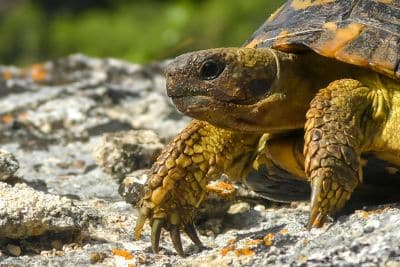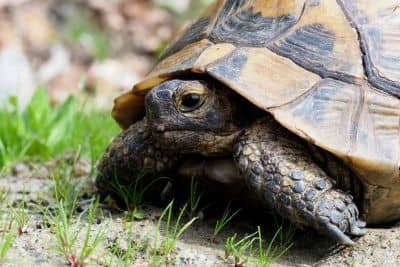Known more commonly as Agassiz’s Desert Tortoise (Gopherus agassizi), the Mojave desert tortoise or simply the desert tortoise, is a fascinating species that calls the American Southwest its home. Supremely adapted for life in the harsh deserts it is native to, this tortoise is unfortunately under threat throughout most of its range, due to habitat destruction and over-collection.
This had led states and the federal government to institute laws protecting the species and greatly limiting the number of people who can legally own them. Nevertheless, for those who’re legally entitled to maintain these animals, they often prove to be excellent pets.
In this article I’ll share some details of this species’ biology, range, and behavior, so you can decide if a Mojave desert tortoise would make a good pet for you.
Agassiz’s Tortoise: Basic Information
This tortoise and the closely related Morafka’s desert tortoise (Gopherus morafkai) were formerly considered the same species. However, scientists studying the DNA of these tortoises realized that they were actually two distinct species, which were found to live on opposite sides of the Colorado River.
Nevertheless, while now considered two distinct species, they’re both quite similar, especially in terms of their physical appearance.
Physical Appearance
The Mojave desert tortoise is built relatively similarly to most other medium-sized tortoises. It has a large, protective shell; a toothless, beak-style mouth; and four pillar-like, elephantine feet. However, it does differ from some other species in several key ways.
For example, though their shells are highly domed when compared with pancake tortoises (Malacochersus tornieri) or other flat-shelled species, they aren’t as highly domed as some other tortoises. This is likely an adaptation that makes it easier for the tortoises to dig long tunnels – an important natural behavior for these animals, which I’ll discuss further below.
Additionally, and also related to their burrowing habits, Agassiz’s desert tortoises also have semi-flattened front legs, which are thought to aid in tunnel construction. The nails on their front legs are also flattened to facilitate digging.
This species has a short tail, though it’s much longer in males than in females (as is the case for most tortoise species). This proves to be one of the best indicators of an individual’s sex, along with the shape of the plastron – it is flat in the case of females and concave in the case of males.
Agassiz’s desert tortoises average about 10 to 14 inches in length, though occasional specimens may grow slightly larger. They’re typically more-or-less unicolored by the time they reach maturity, with their colors ranging from tan to nearly black. However, hatchlings often have more contrasting patterns, consisting of light spots in the center of each carapace scute.
Natural Habitat & Range
The Agassiz’s desert tortoise is primarily confined to the Mojave desert, including portions of California, Nevada, Utah, Arizona, and Mexico. However, they are found in a small portion of the Sonoran Desert too (though they’re confined to the area west of the Colorado River).
They inhabit a variety of different habitats within this range, but they’re all quite arid. These chelonians show a distinct preference for areas with soils that are conducive to burrow formation, including canyon bottoms and areas bordering streambeds.
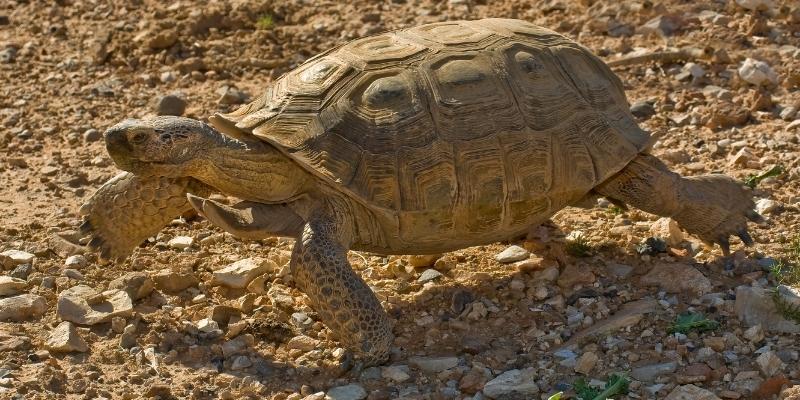
Natural Behaviors
Agassiz’s desert tortoises are like most other members of the genus Gopherus, in that they spend a lot of time and effort constructing long tunnels.
These tunnels, which may extend for more than 50 feet and penetrate more than 10 feet below the surface, are critical for the animals’ survival in the wild, as they provide a retreat from the soaring desert temperatures of their homeland. The burrows also offer protection from predators and help prevent the tortoises from becoming too cold in the winter or at night. Some scientists estimate that these tortoises spend more than 90% of their lives inside the confines of their burrows.
Like most other tortoises, the Agassiz’s desert tortoise is most active early in the morning, before the sun drives temperatures too high. Some individuals may also become active again in the late afternoon. Agassiz’s desert tortoises are usually active from March to October, and they brumate (the reptilian equivalent of hibernation) through the winter season.
Interestingly, these tortoises consume the bulk of their yearly calories during April and May, when the local wildflowers are most abundant. They still feed during the rest of the active season, but they consume fewer calories on average.
Captive Care: Maintaining an Agassiz’s Tortoise
Again, it is important to verify the legal status of Mojave desert tortoises in your area before trying to keep one as a pet. They are protected in many places, which makes owning one a crime.
However, for those who’re legally entitled to keep one of these amazing tortoises, they often make good pets.
Enclosure & Space Requirements
Agassiz’s tortoises are a medium-sized tortoise species, with space requirements that are similar to those of other mid-sized chelonians. Generally, this means you’ll want to provide your pet with about 30 to 50 square feet of space. This is obviously not easy to do indoors, so most keepers maintain Mojave desert tortoises outdoors in a predator-proof enclosure (though juveniles can be housed indoors if you wish).
You’ll generally need to construct a custom-built enclosure to do so, as large outdoor enclosures aren’t sold commercially (at least, not in the sizes you’d need for these animals). Most such enclosures will feature solid walls and a top to keep out predators.
The walls can be made from plastic panels, corrugated metal, cement blocks, or moisture-sealed wood. The top, on the other hand, should be made from hardware cloth, chain-link fence, or a similar material, which will allow sunlight to shine through.
Note that because these tortoises are accomplished diggers, you’ll also need to take steps to prevent escapes. There are essentially two ways to help reduce the chances of your tortoise tunneling out of the enclosure and escaping:
- Install a “floor” beneath the enclosure. You’ll still want to place a deep layer of substrate over the floor, so you’ll likely need to excavate the entire area to a depth of several feet. You can then place the floor at the bottom and cover it with several feet of soil.
- Use walls that penetrate several feet beneath the surface. This is an easier approach, but it doesn’t completely eliminate the possibility of an escape. Needless to say, the deeper the walls penetrate below ground level, the more likely they are to keep your pet contained.
Are You Starving Your Tortoise?
Save 10% on premium tortoise food and supplements from Tortoise Resource Center on Amazon now using code BUYNOWGET10
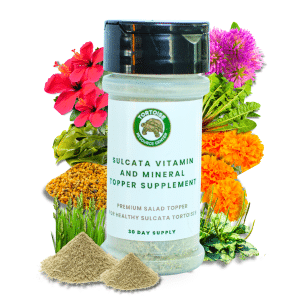
Sulcata Vitamin & Mineral Topper Supplement
30-Day Supply | 2 oz (56 g)
$24.99
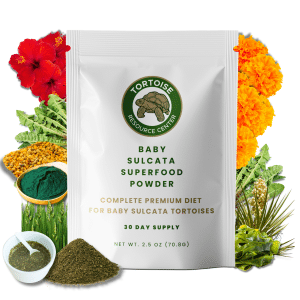
Baby Sulcata Tortoise Superfood Powder
30-Day Supply | 2.5 oz (70.8 g) Bag
$24.99
Heating, Lighting, & Humidity
If you are keeping your tortoise outdoors, you don’t have to worry about installing heating or lighting devices – in fact, it’s wise to avoid doing so, given that most such devices are not designed for outdoor use. However, this also means you’ll need to live in an area with a climate that is roughly similar to the climate of the Mojave Desert.
This means your tortoise will need a basking area in the habitat that receives full sun exposure and enjoys ambient temperatures in the 90- to 100-degree-Fahrenheit range (note that the surface temperatures will often be higher than this – that is normal). You’ll also need to ensure that the there are several shaded areas in the enclosure, which stay cooler than this during the heat of the day.
Finally, you’ll need to ensure that the nighttime temperatures do not fall below the mid-60s for most of the year (it is fine if they do so during the winter, when your tortoise will be brumating).
But if you’re maintaining a tortoise indoors, you’ll need to install heating and lighting devices. It is important to understand that your tortoise doesn’t only need a proper thermal environment, but he also requires exposure to full-spectrum lighting, including rays in the UVA and UVB portions of the spectrum (tortoises reared outdoors obtain this from natural, unfiltered sunlight).
There are several different types of lighting and heating devices you can use to provide these things. You essentially have six basic options you can use:
- Radiant heat panels: Radiant heat panels are great for supplying warmth to your pet’s enclosure, but they don’t produce any light. So, you’ll have to use them alongside full-spectrum light fixtures. Radiant heat panels must be used with a thermostat to regulate the amount of heat they provide.
- Mercury vapor lights: Mercury vapor lights are the only option (aside from the sun) that provide both heat and full-spectrum light. They are, however, more expensive than most other kinds of lights.
- Incandescent heat lights: Incandescent lights produce heat and some light, but they’re incapable of producing light in the UVB portion of the spectrum. Accordingly, you’ll need to use them with full-spectrum lights to keep your pet healthy.
- LED lights: LED lights provide an energy-efficient way to provide your pet with light and exposure to UVA and UVB rays. However, they do not produce enough heat to keep the habitat or basking spot warm. So, you’ll need to use them alongside incandescent bulbs or radiant heat panels.
- Linear fluorescent tubes: Linear fluorescent tubes are great for illuminating large portions of your pet’s habitat, but they do not produce heat. Additionally, they require special fixtures, thereby presenting an additional cost for keepers.
- Compact fluorescent bulbs: Compact fluorescent bulbs do not produce heat, so they must be used with heating devices of some kind. However, they do not require the specialized fixtures that linear fluorescent tubes require, which makes them more convenient to install.
No matter which type of lights and heating devices you choose, be sure to cluster them at one end of the enclosure. This creates a thermal gradient (a range of temperatures) within the enclosure. This allows your tortoise to adjust his temperature by moving to different spots inside the enclosure.
Additionally, be sure to connect the lights to a timer. This will make it easier to maintain a consistent day-night schedule for your pet.
Substrate, Decorations, & Enrichment
With the enclosure set up, you can now turn your attention to the things that go inside your pet’s habitat. This includes a suitable substrate and several items to serve as enrichment for your pet and decoration for you (your tortoise doesn’t care about how the enclosure is decorated).
The ideal substrate for Mojave desert tortoises is either soil or a custom-blended soil-and-sand mixture. You may have to experiment to arrive at the proper ratio and consistency, as you’ll want it to be able to support tunnel formation. It may also be necessary to add a little water to the mix to get the right consistency.
Generally speaking, you’ll want the substrate to form a flat bottom, but gentle slopes or small hills are acceptable to include. In fact, these are likely the places your tortoise will decide to start a tunnel.
With the substrate in place, you can start adding enrichment items and decorations – you should never keep a tortoise in a completely empty enclosure.
Some of the most common things keepers like to add to an enclosure include driftwood, live (non-toxic) plants, and stones. However, be sure that any heavy items, such as stones, are small enough that they won’t injure your tortoise, should he tunnel beneath them.
You should also provide at least two hiding places in every tortoise habitat. One should be placed on the warm side of the enclosure, and the other should be placed at the cool end. This way, your tortoise doesn’t have to choose between security and the temperature range he currently desires. It is possible (potentially even likely) that your tortoise will prefer using his tunnels, but you should still include hiding places in every tortoise habitat.
Food & Water
Feeding Agassiz’s desert tortoises is generally relatively easy. In the wild, they subsist on a variety of grasses, weeds, sedges, herbaceous plants, and fruits, but flowers are thought to form the largest portion of their diet.
However, while you’ll want to include plenty of edible flowers in your tortoise’s diet, they needn’t serve as the bulk of his calories. A variety of leafy green vegetables, non-toxic grasses, and the occasional bit of fruit will suffice. Many individuals may also enjoy needle-free cactus pads.
You can feed adult Agassiz’s tortoises five or six times per week, but juveniles should be fed every day. Note that Mojave desert tortoises may consume invertebrates and carrion in the wild on occasion, but it is neither necessary nor recommended to offer these items in captivity.
Your Agassiz’s desert tortoise will likely obtain most of the moisture he needs via the fruits and vegetables he consumes, but it is still important to provide him with clean, fresh water at all times. Make sure that you offer the water in a wide, shallow dish, so that it’s easy for him to reach and access.

Ongoing Agassiz’s Tortoise Care
Setting up your pet’s enclosure is only part of the husbandry process; you must also provide several types of on-going care and maintenance. The specific type of care you’ll need to provide will vary slightly depending on your situation, the type of enclosure you use, and your pet’s age, but a typical care regimen would unfold as follows:
- Clean your pet’s enclosure every day. Enclosure hygiene is a critical factor in your pet’s well-being, so be sure to remove any feces, shed scutes, or uneaten food in the habitat each day.
- Monitor the temperatures within the habitat on a daily basis (for the first several months). It is critical that you provide your pet with a proper thermal environment, so be sure to measure the ambient temperatures in the hottest and coolest portions of the enclosure on a daily basis. After the enclosure has been established for some time, and you’re confident that the temperatures are remaining within the proper range (90 to 95 degrees Fahrenheit on the warm side and somewhere in the mid-70s on the cool side), you can reduce the frequency at which you check the temperatures.
- Soak your tortoise on a regular basis. Many keepers find it helpful to provide 30-minute soaking sessions for their tortoises. This not only helps to keep your tortoise’s plastron cleaner, but it also ensures proper hydration. Just be sure to use room temperature water and keep it shallow enough that your tortoise can easily breathe without struggling. It is wise to soak young tortoises several times per week, but older tortoises can thrive when soaked a few times per month.
- Break down the habitat and clean the individual components every few months. Bacteria and fungi can build up in the inaccessible cracks and crevices of your pet’s habitat. So, you’ll want to take everything apart that you reasonably can and clean the individual items.
- Replace the substrate in the enclosure two to four times per year. Even though you’ll be cleaning the substrate on a daily basis, it’ll still become contaminated over time. So, you’ll want to remove and replace the substrate approximately two to four times per year. This is not especially easy for large outdoor enclosures, so it may be necessary to conduct several partial substrate replacements over the course of the year.
- Replace the UVB-producing light fixtures on the schedule recommended by the manufacturer. If you’re maintaining your pet indoors, you’ll need to replace the full-spectrum lights over time, as they’ll stop producing high levels of UVB with use. Most manufacturers will provide a recommended replacement schedule on the product package, but in the absence of this, you’ll want to replace them once or twice a year.
Citations
- National Park Service – Desert Tortoise (Gopherus agassizii)
- Desert Tortoise Council – Biology of Desert Tortoises
- US Fish & Wildlife Service – Desert Tortoise

